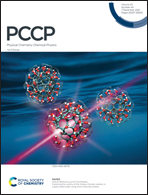A study on the multiferroic properties of semi-hydrogenated X2H (X = C, Si, and Ge) monolayer films†
Abstract
In recent years, the research on the physical properties of two-dimensional (2D) materials has attracted much attention. In this paper, the magnetic and ferroelectric (FE) properties of semi-hydrogenated graphene, silylene and germanene X2H (X = C, Si, and Ge) under strain are systematically investigated. The results have shown that X2H is a magnetic FE semiconductor with ferromagnetic (FM) and FE structures, both perpendicular to the plane, a large energy gap, and a high polarization reversal barrier. It is found that both the polarization reversal barrier and the magnitude of FE polarization gradually decrease, but the FM state remains the same, upon gradually increasing the tensile strain. As the tensile strain is increased to 19%, the barriers of the Si2H and Ge2H monolayer films to flip a single valence bond are decreased to 1.123 eV and 0.768 eV, respectively, and the systems still maintain semiconductor characteristics. When the strain is increased to 20%, the films begin to show metallicity in the plane of films, but still have the polarity perpendicular to the plane because of the anisotropy of the band structure. These research results suggest that the magnetoelectric properties of Si2H and Ge2H monolayer films provide the possibility for achieving a new generation of information storage materials.



 Please wait while we load your content...
Please wait while we load your content...